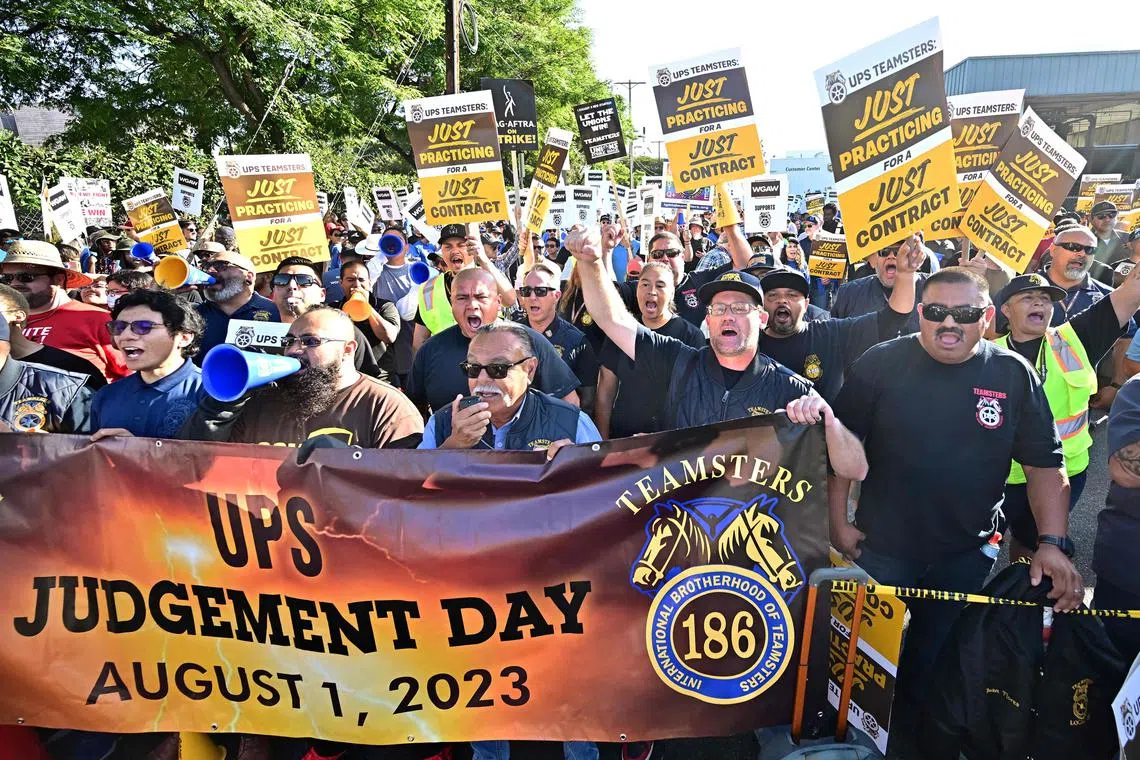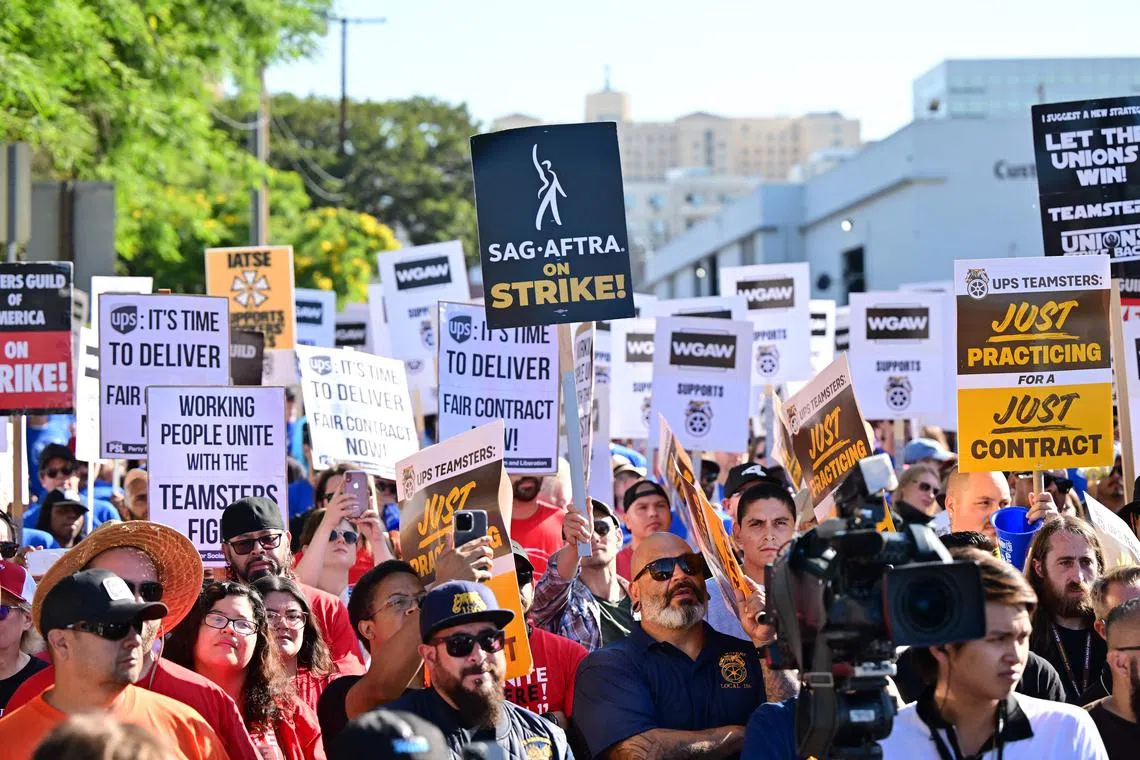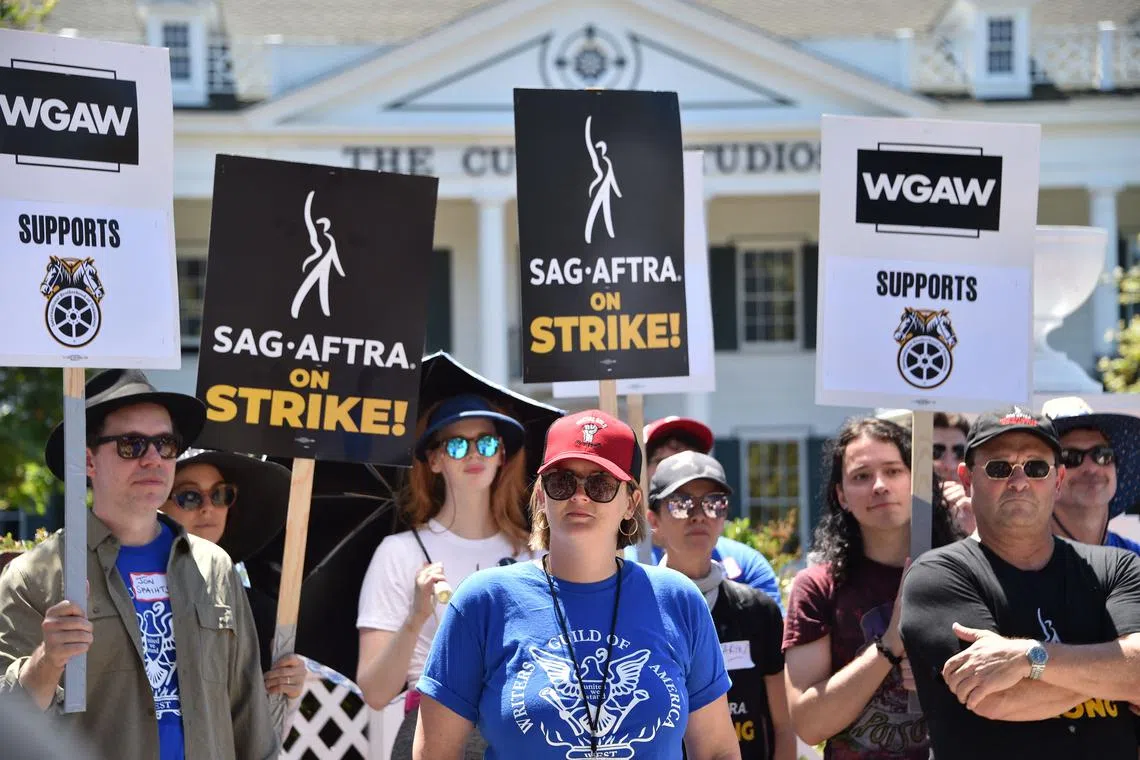The US is barrelling towards a summer of strikes
Sign up now: Get ST's newsletters delivered to your inbox

UPS is confronting difficult headwinds with package demand declining as the country emerges from the pandemic.
PHOTO: AFP
Follow topic:
MICHIGAN – More than 650,000 American workers are threatening to go on strike this summer – or have already done so – in an avalanche of union activity not seen in the United States in decades.
The combined actors and writers strikes in Hollywood
Unions for United Parcel Service (UPS) and Detroit’s Big Three automakers – General Motors, Ford Motor and Stellantis (formerly Chrysler) – are poised to join them in coming weeks if contract negotiations fall through.
One Bank of America analyst put the odds of a United Auto Workers (UAW) strike at more than 90 per cent.
And while logistics experts and financial analysts expected the Teamsters – the union representing roughly 340,000 workers – to reach a deal with UPS, their confidence has dwindled as the July 31 deadline approaches.
“This will be the biggest moment of striking, really, since the 1970s,” said labour historian Nelson Lichtenstein, who directs the University of California, Santa Barbara’s Centre for the Study of Work, Labour and Democracy.
Even before the 100,000-plus actors joined in last week, both the number of strikes and workers on strike were up in the first half of this year, according to Bloomberg Law labour data.
Similar trends are playing out in other countries: A cost-of-living crisis has unions across Europe flexing their muscles, with the Britain losing the most working days to strikes in decades.
The pandemic years have, in some ways, reenergised American labour. Emboldened by tight labour markets and agitated after shouldering new risks, workers notched a series of surprising victories at some of the most prominent US companies.
Now, wary of soaring corporate profits as major technological changes threaten to upend their industries, unions are ready to test their clout.
“There’s an ambition here that I think is new,” said Dr Lichtenstein. “They’re on the offence.”
The companies, for their part, are facing their own economic realities.
In Hollywood, studio profits are down because of a shift to streaming and Wall Street has punished companies for their lagging financials. UPS is confronting difficult headwinds, with package demand declining as the country emerges from the pandemic. The carmakers say they already offer generous pay and benefits and need to keep wages competitive with lower-paying rivals like Tesla as they invest billions into the shift to electric vehicles.
“It’s very clear that unions are quite alive,” said Mr Michael Lotito, who co-chairs the Workplace Policy Institute at the management law firm Littler. “The jury’s out on how well they are.”

Workers across industries are pushing for a bigger share of corporate profits, particularly as inflation has bitten into their paychecks.
PHOTO: AFP
The showdowns could have sweeping consequences, not just for the hundreds of thousands of workers striking, but for the much-diminished American union landscape.
The share of the US private sector that is unionised has fallen from one-quarter half a century ago to just 6 per cent today. Few groups have as much leverage to upend company plans, capture public attention and force concessions as the organised workers who deliver Americans’ packages, make their cars and entertain them.
“In terms of workers in America who still have the ability to change their conditions, these are three of the top 10,” said Mr Larry Cohen, a former Communications Workers of America union president, who now chairs the advocacy group Our Revolution.
If the unions come out on top, it could boost organising efforts at companies like Amazon and Starbucks that, despite recent wins, still remain largely union free. Teamsters president Sean O’Brien has said he plans on using the union’s success to win over Amazon workers.
“Hopefully, Amazon employees look at this and go: ‘You know what? We deserve this too,’” said Minnesota UPS warehouse worker Rikki Schreiner, who has been at the company for two decades.
The launch of strikes could galvanise even non-union workers, but the move doesn’t come without risks.
Drawn-out stoppages can drain member finances, and the union’s – making it harder to fund other efforts.
Strikes that lose momentum can leave members divided and disillusioned. If fights end with disappointing deals, they could become cautionary tales. Managers often hold up unproductive and costly strikes as a reason to not unionise.
“Workers are watching each other and trying to learn from each other,” said Ms Sharon Block, who served in former president Barack Obama’s Labour Department and now directs Harvard Law School’s Centre for Labour and a Just Economy.
The details of the current clashes themselves vary, but one thing they have in common is money.
Workers across industries are pushing for a bigger share of corporate profits, particularly as inflation has bitten into their pay cheques. Actors and writers want higher base pay and more residuals from streaming shows. The auto workers not only want raises, but to ensure the people powering the shift to electric cars get the same pay and benefits as other plant workers. UPS Teamsters members have not forgotten how “essential” their work was during pandemic lockdowns, and think they should be compensated accordingly.
“If my work is so important, then why shouldn’t I be properly rewarded for it?” said UPS employee Nick Marrapode of Portland, Oregon.
Workers also say past contract deals gave some staff worse terms than peers.
One issue in the Hollywood stoppage is that talk show and game show writers for streamers – including giants such as Netflix – lack the contractual protections provided to their counterparts working for cable stations, even tiny ones. UAW members are pushing to end “two-tier” arrangements that pay newer employees significantly worse than long-timers, and UPS staff are pushing to close the gap between full- and part-time worker compensation.
“UPS needs to share the billions of dollars that they made with their workers,” said Mr Scott Gove, a 35-year UPS employee in New Hampshire. “I think that that’s a bitter pill for them.”
An undercurrent of major technological and societal changes is driving some worker anxieties, too.
Writers’ rallies have been studded with signs about the dangers of artificial intelligence.
“Only uncreative people would think that you can replace writers and actors with artificial intelligence and that it would be interesting or any good,” said Chaley Rose, a SAG-Aftra actors’ union member best known for playing Zoey Dalton in the television series Nashville.

Hundreds of SAG-AFTRA members signed an open letter to union officers including their new president Fran Drescher.
PHOTO: AFP
The UAW is pushing to secure a path for electric-vehicle and battery workers to unionise as the industry shifts to greener options. The Teamsters got a commitment to add air conditioning in the iconic brown trucks, a necessity in a warming planet.
The negotiations are testing new union leadership. Both the Teamsters and UAW presidents won their seats in the past two years, in part, by promising to reverse past concessions. One galvanising issue in the Teamsters’ showdown was members’ frustration with the prior leadership’s decision to push through a UPS contract deal in 2018 that a majority of the membership had voted to reject.
UAW president Shawn Fain has said he is going to “war” against the Detroit automakers, and last week he eschewed the traditional handshake-across-the-bargaining-table with chief executives that has marked the opening of auto contract talks for decades, saying he will do so “when they come to the table with a deal”.
Hundreds of SAG-Aftra members signed an open letter to union officers including their new president Fran Drescher, star of the 1990s TV show The Nanny, saying they were ready to strike and were concerned “that SAG-Aftra members may be ready to make sacrifices our leadership is not”.
Drescher responded by adding her name to the letter.
Strikes of this scale were not always scarce in the US. At least 800,000 workers were involved in work stoppages every year throughout the 1950s. Their cadence has plummeted along with overall unionisation rates.
But in recent years, public opinion of unions has ticked up to highs not seen in decades.
“Unions are viewed very much as a solution now,” said Mr Seth Harris, a former deputy National Economic Council director under US President Joe Biden. “They’re not viewed as a museum piece.”
The strikes will now test their power. BLOOMBERG

